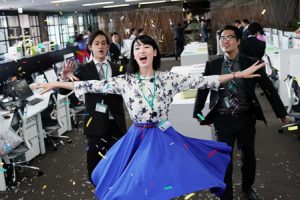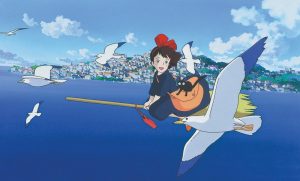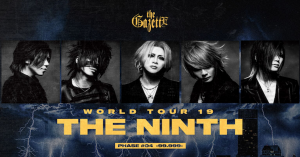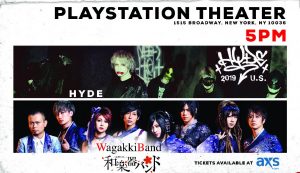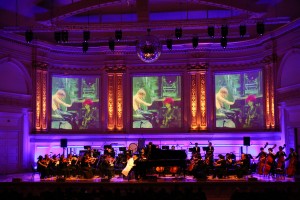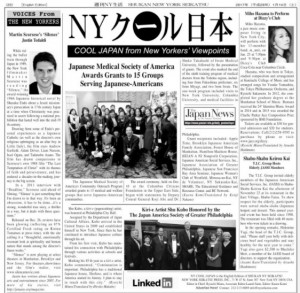JQ Magazine: Nippon in New York — Mr. Big Farewell, ‘Paprika’ in 4K, ‘Stardew Valley’ in Concert
By JQ magazine editor Justin Tedaldi (CIR Kobe-shi, 2001-02). Justin has written about Japanese arts and entertainment for JETAA since 2005. For more of his articles, click here.
Stay warm this winter with some hot local events, from live showcases that will transport you to another time and place, some new film screenings, and a rock performance you won’t want to miss.
This month’s highlights include:
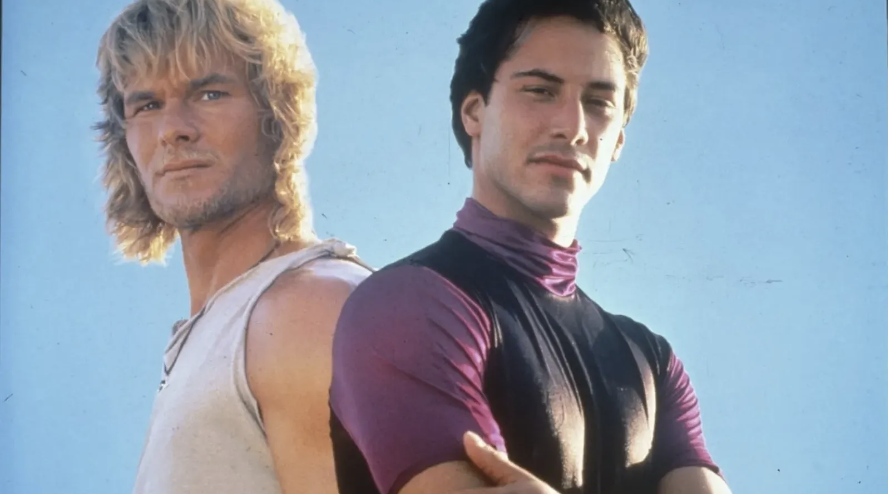
Feb. 2-3
Metrograph, 7 Ludlow Street
$17, $10 members
From Academy Award-winning director Kathryn Bigelow, Point Break stars Keanu Reeves as Johnny Utah, an FBI agent who goes undercover among the beach bums in order to investigate a hunch about surfers who are possibly moonlighting as bank robbers, in the film that cemented Reeves as a new, very California cool kind of action star. With Patrick Swayze as the group’s guru and kingpin, Point Break is the kind of smart, fun, sexy, exciting action film desperately lacking in today’s Hollywood. This all-new 4K restoration is courtesy of Shout! Factory in association with Resurgence Media Group.

Tuesday, Feb. 6, 7:30 p.m.
Sony Hall, 235 West 46th Street
$45 standing room only, $85 VIP reserved seating
One of the most successful American exports to rock Japan, Mr. Big is putting on their signature top hats and old shoes one last time for a worldwide tour, aptly titled “The Big Finish.” Since the band’s original drummer and co-founder, Pat Torpey, lost his battle with Parkinson’s disease in 2018, joining Mr. Big on drums for this special final world tour will be longtime friend of the band Nick D’Virgilio (Spock’s Beard, Big Big Train). Of note for this final run is the band’s decision to perform the entirety of their breakthrough platinum-selling 1991 album Lean Into It from start to finish as a featured highlight of the live setlist, along with other tunes from Mr. Big’s entire career. Lean Into It is the perfect litmus testament to the band’s inherent dexterity at blending a variety of styles together, whether it’s the heady rocking brew of “Green-Tinted Sixties Mind,” the power-drilled and power-chorded identity checklist “Daddy, Brother, Lover, Little Boy,” or the truly heartfelt sentiments found within “To Be With You,” Mr. Big’s chart-topping, worldwide #1 smash hit single.

Feb. 7, 8, 11
Various theaters
Various prices
Anime Expo Cinema Nights presents the final film ever made by visionary director Satoshi Kon (Perfect Blue, Tokyo Godfathers) with his mind-bending thriller Paprika, which has been restored in 4K for the first time ever! When a machine that allows therapists to enter their patients’ dreams is stolen, all hell breaks loose. Only a young female therapist, Paprika, can stop it. Dreams become reality and vice versa in this psychological fantasy you won’t want to miss! Featuring the voice talents of Megumi Hayashibara, Kōichi Yamadera, and Tôru Furuya.
Read MoreJQ Magazine: Nippon in New York — ‘The Boy and the Heron,’ ‘Blue Giant,’ Yoshiki Classical ‘REQUIEM’
By JQ magazine editor Justin Tedaldi (CIR Kobe-shi, 2001-02). Justin has written about Japanese arts and entertainment for JETAA since 2005. For more of his articles, click here.
As the summer sun fades into fall colors, the weeks ahead are shaping up with these exciting events, ready to be enjoyed all through Halloween.
This month’s highlights include:

Sunday, Sept. 24, 6:00 p.m.
Gramercy Theatre, 127 East 23rd Street
$53.66
Hanabie is a sensational hybrid-girl-band with their original genre, “Harajuku-core,” which is a mix of metalcore and hardcore with Akihabara culture. Formed in 2015, members Yukina, Matsui, Hettsu and Chika are now on a massive 21-date American tour, including the Louder Than Life and Aftershock festivals! Joining them on these and upcoming dates are Denver’s Fox Lake, a hip-hop-injected metal band that most recently released their Fear & Loathing EP in June. For videos and more info on future gigs, visit www.foxlakeband.com.

Oct. 1-2, 12, 14
Alice Tully Hall, 1941 Broadway
$25 students, $30 non-members
U.S. premiere as part of the 61st New York Film Festival! The first feature in a decade from Hayao Miyazaki is a ravishing, endlessly inventive fantasy that is destined to be ranked with the legendary animator’s finest, boldest works. While the Second World War rages, the teenage Mahito, haunted by his mother’s tragic death, is relocated from Tokyo to the serene rural home of his new stepmother Natsuko, a woman who bears a striking resemblance to the boy’s mother. As he tries to adjust, this strange new world grows even stranger following the appearance of a persistent gray heron, who perplexes and bedevils Mahito, dubbing him the “long-awaited one.” Indeed, an extraordinary and grand fate is in store for our young hero, who must journey to a subterranean alternate reality in the hopes of saving Natsuko—and perhaps himself. Uniting the countryside surreality of My Neighbor Totoro with the Alice in Wonderland–like dream logic of Spirited Away and the personal historical backdrop of The Wind Rises (NYFF51), yet fabricating something ingeniously original, The Boy and the Heron is a deeply felt work of eccentric beauty brimming with inspired images that lodge in the mind, from the adorable to the grotesque. Moving from earthbound serenity to a universe of boundless imagination, Miyazaki’s long-anticipated film seeks, once and for all, a world without malice. Presented in Japanese with English subtitles.

Oct. 5, 7, 11
Alice Tully Hall, 1941 Broadway
Howard Gilman Theater, 144 West 65th Street
$25 students, $30 non-members
U.S. premiere! Deep in the forest of the small rural village Harasawa, single parent Takumi lives with his young daughter, Hana, and takes care of odd jobs for locals, chopping wood and hauling pristine well water. The overpowering serenity of this untouched land of mountains and lakes, where deer peacefully roam free, is about to be disrupted by the imminent arrival of the Tokyo company Playmode, which is ready to start construction on a glamping site for city tourists—a plan, which Takumi and his neighbors discover, that will have dire consequences for the ecological health and cleanliness of their community. The potent and foreboding new film from Oscar-winning director Ryûsuke Hamaguchi (Drive My Car and Wheel of Fortune and Fantasy, both NYFF59) is a haunting, entirely unexpected cinematic experience that reconstitutes the boundaries of the ecopolitical thriller. Intensified by a rapturous, ominous score by Eiko Ishibashi, this mesmeric journey diverges from country-vs-city themes to straddle the line between the earthy and the metaphysical. Presented in Japanese with English subtitles. Q&A with Ryûsuke Hamaguchi on Oct. 5 & 7.
Read MoreJQ Magazine: Nippon in New York — Yayoi Kusama, Kyary Pamyu Pamyu, MAN WITH A MISSION
By JQ magazine editor Justin Tedaldi (CIR Kobe-shi, 2001-02). Justin has written about Japanese arts and entertainment for JETAA since 2005. For more of his articles, click here.
As spring continues and the weather continues to warm, New Yorkers can enjoy activities all over the city both indoors and out.
This month’s highlights include:
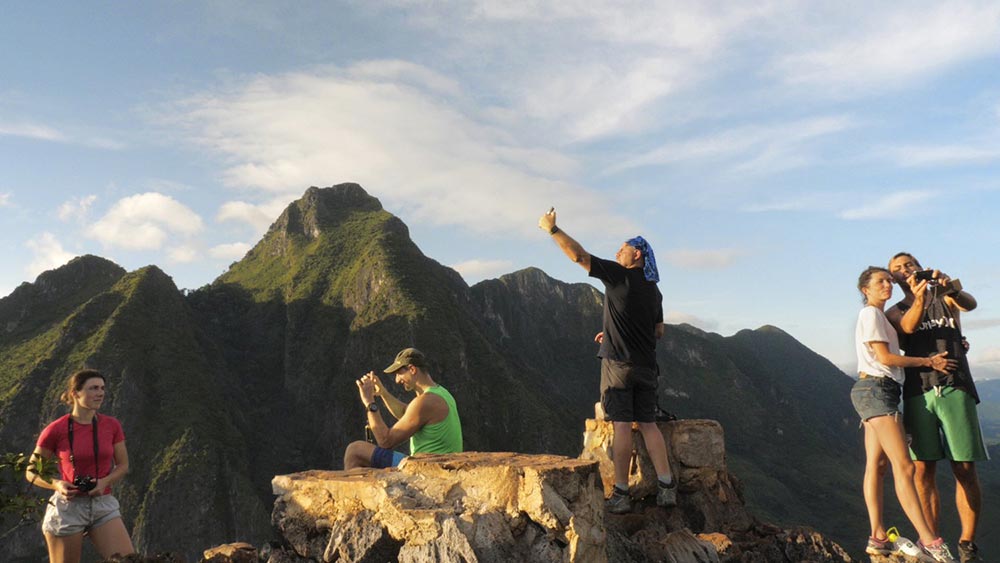
Thursday, May 4, 7:00 p.m.
Peter Jay Sharp Building, 30 Lafayette Avenue
$16, $8 members
Kimi Takesue’s Onlookers asks looming existential questions such as: Why do we travel? What do we seek? Onlookers offers a visually striking, immersive meditation on travel and tourism in Laos [which is also the most heavily bombed per capita in history after the U.S. dropped over 2 million tons of bombs from 1964-1973], reflecting on how we all live as observers. Unfolding in painterly tableaux, Onlookers explores the paradox of travel: Why do people fly thousands of miles from home to lounge in a Laotian guest house sipping smoothies while watching reruns of the TV show Friends? Why do we climb to the top of a colossal mountain just to snap selfies, rather than enjoy the extraordinary view? We are present, but absent. Looking, but not seeing.

Opens May 11
Yayoi Kusama: I Spend Each Day Embracing Flowers
David Zwirner, 519, 525 & 533 West 19th Street
Free
One of the most celebrated contemporary artists of our time, Yayoi Kusama unveils her latest works in one of her largest gallery exhibitions to date here in New York. The exhibition features new paintings, new sculptures elaborating on her signature motifs of pumpkins and flowers, and a new Infinity Mirrored Room. Born in 1929 in Matsumoto, Japan, Kusama’s work has been featured widely in both solo and group presentations. She presented her first solo show in her native Japan in 1952. In the mid-1960s, she established herself in New York as an important avant-garde artist by staging groundbreaking and influential happenings, events, and exhibitions. Her work gained renewed widespread recognition in the late 1980s following a number of international solo exhibitions, including shows at the Center for International Contemporary Arts, New York, and the Museum of Modern Art, Oxford, both of which took place in 1989.

Monday, May 15, 8:00 p.m.
Webster Hall, 125 East 11th Street
$35
Pop singer and icon of Harajuku fashion Kyary Pamyu Pamyu returns to New York for the debut date of her first U.S. tour in five years, supported by French-born and Tokyo-based DJ Moe Shop! last month, the two collaborated on their new song CANDY CANDY (Moe Shop Remix). As fans of KPP know, she’s been a J-pop icon since she first amassed a following as a teenage fashion blogger. She later rose to global fame as a viral Jpop music video star, model, and actress, even starring in numerous Japanese TV commercials. Kyary Pamyu Pamyu has sold over 970,000 physical albums and singles in Japan according to Oricon as well as over 2.25 million downloads of her singles, drawing favorable comparisons to Katy Perry and Lady Gaga in her home country. Don’t miss one of the most colorful pop performers ever to take the stage!
Read MoreKrewe of Japan Podcast S02E14-15 – Mastering Japanese Pitch-Accent ft. Dogen (Parts 1 & 2)
Posted by: Doug Tassin (Fukushima-Ken ALT, 2007-2010 & Krewe of Japan Podcast Co-Host)

Last week on the Krewe of Japan Podcast…
The whole Krewe sits down with famous comedian and Youtuber (and former JET Program participant in Oita Prefecture), Dogen! In Part 1, Dogen shares his background including how he became interested in Japan and its culture, his background in martial arts tricking, early attempts at learning Japanese, his path to writing comedy in Japanese, and so much more.
This week…
Nigel, Jenn, & Doug conclude their awesome discussion with comedian and Youtuber, Dogen! In Part 2, the Krewe joins Dogen as they embark on a deep dive into learning Japanese. This discussion takes them to many places from discovering the meaning of pitch accent and how to study effectively, to setting appropriate goals and hilarious language learning stories. This is an episode you don’t want to miss!
The Krewe of Japan Podcast is a weekly episodic podcast sponsored by the Japan Society of New Orleans. Check them out every Friday afternoon around noon CST on Apple, Google, Spotify, Amazon, and Stitcher. Want to share your experiences with the Krewe? Or perhaps you have ideas for episodes, feedback, comments, or questions? Let the Krewe know by e-mail at kreweofjapanpodcast@gmail.com or on social media (Twitter: @kreweofjapan, Instagram: @kreweofjapanpodcast, Facebook: Krewe of Japan Podcast Page, & the Krewe of Japan Youtube Channel). Until next time, enjoy!
Krewe of Japan Podcast E19 – Sake Sippin’ with Brian Ashcraft
Posted by: Doug Tassin (Fukushima-Ken ALT, 2007-2010 & Krewe of Japan Podcast Co-Host)

This week on the Krewe of Japan Podcast…
Did you know New Orleans is the home to the Gulf Coast’s only sake brewery? The Krewe didn’t until a few weeks ago! Nigel & Doug sit down reminisce about their first encounters with sake before sitting down for a sake deep dive with Brian Ashcraft, author of the award winning Japanese Sake Bible. Brian talks about what led to his interest in Japan and sake, shares some behind-the-scenes info into the creation of his comprehensive guide to Japanese rice wine, and provides insight on things that all sake enthusiasts need to know. Kanpai!
And check out last week’s episode in case you missed it! Episode 19 – Greatest Anime of All-Time pt. 3 – Modern Day Anime (2010 – present) – closes out the anime mini-series, spotlighting some of the biggest anime of today (we’re looking at you Demon Slayer, Attack on Titan, & My Hero Academia). The Krewe also digs into how sub-genres took the main stage and how streaming platforms completely changed the game.
The Krewe of Japan Podcast is a weekly episodic podcast sponsored by the Japan Society of New Orleans. Check them out every Friday afternoon around noon CST on Apple, Google, Spotify, Amazon, and Stitcher. Want to share your experiences with the Krewe? Or perhaps you have ideas for episodes, feedback, comments, or questions? Let the Krewe know by e-mail at kreweofjapanpodcast@gmail.com or on social media (Twitter: @kreweofjapan, Instagram: @kreweofjapanpodcast, Facebook: Krewe of Japan Podcast Page, & the Krewe of Japan Youtube Channel). Until next time, enjoy!
Posted by: Doug Tassin (Fukushima-Ken ALT, 2007-2010 & Krewe of Japan Podcast Co-Host)

This week on the Krewe of Japan Podcast…
Jennifer & Doug unsheathe their verbal katana as they talk about Netflix’s hit documentary Age of Samurai: Battle for Japan. Notably, the documentary introduced a cast of overlooked historical figures who played a prominent role in the Sengoku Period, the Lady Samurai. Tomoko Kitagawa, a narrator featured in Age of Samurai & Japanese historian, joins the Krewe to highlight the impact of these influential women, as well as share some stories of her journey from study abroad student to world-renown historian and best-selling author. This is an interview you won’t want to miss!
The Krewe of Japan Podcast is a weekly episodic podcast sponsored by the Japan Society of New Orleans. Check them out every Friday afternoon around noon CST on Apple, Google, Spotify, Amazon, and Stitcher. Want to share your experiences with the Krewe? Or perhaps you have ideas for episodes, feedback, comments, or questions? Let the Krewe know by e-mail at kreweofjapanpodcast@gmail.com or on social media (Twitter: @kreweofjapan, Instagram: @kreweofjapanpodcast, Facebook: Krewe of Japan Podcast Page, & the Krewe of Japan Youtube Channel). Until next time, enjoy!
JQ Magazine: JQ&A with Director Shinya Tsukamoto at JAPAN CUTS

“In the film Killing, I don’t necessarily have one political message that’s strongly pursued, and I want the audience to figure out the film’s message for themselves. Personally speaking, I find it to be incredibly frightening today of what the Japanese government is doing.” (Courtesy of Shinya Tsukamoto)
By Lyle Sylvander (Yokohama-shi, 2001-02) for JQ magazine. Lyle used to work in New York City for Merchant Ivory Productions and the National Geographic Channel. He currently teaches history, international relations and film at an international high school in Shanghai, China.
Shinya Tsukamoto is a Japanese filmmaker most famous for his Tetsuo trilogy of horror/sci-fi films: Tetsuo: The Iron Man (1989), Tetsuo II: Body Hammer (1992), and Tetsuo: the Bullet Man (2009). Other films include Hiruko the Goblin (1991), Bullet Ballet (1998), and Tokyo Fist (1995). He has also acted in most of his own films as well as those of others, most recently in Martin Scorsese’s Silence (2016).
Last week, Tsukamoto made a special appearance at Japan Society in New York City for their annual JAPAN CUTS film festival to receive their prestigious CUT ABOVE Award for Outstanding Achievement in Film, as well as to speak at the East Coast premiere of his latest film, Killing. In this exclusive interview, JQ spoke with the director about violence and politics in his work, lifelong influences, and the story behind the name of his most enduring creation. (Translation by Aiko Masubuchi.)
You have stated that Killing was made in response to the violence you see today in society. All of your previous films have dealt with violence in one way or another—how is your position towards violence different in this film than in others?
When I was little, and for a long time, of course there were some violent things that happened in Japan, but mostly speaking, the violence was outside Japan and Japan was a country that would try to avoid war. It was that way for a long period of time. So, in my earlier films, the violence I was depicting was more fantastical. But now, times have changed: Japan is turning into a country that is getting ready to go to war, and so I could no longer depict violence through a fantastical lens—I needed to depict violence as something realistic and scary and use it as a warning, and so could no longer depict violence the same way.
Does this mean that your film is in response to the Abe administration’s recent foreign policy and re-militarization of Japan?
In the film, I don’t necessarily have one political message that’s strongly pursued, and I want the audience to figure out the film’s message for themselves. Personally speaking, I find it to be incredibly frightening today of what the Japanese government is doing.
How does your version of Nobi (Fires on the Plain) differ from Kon Ichikawa’s classic version of the same anti-war story?
I am a huge fan of Kon Ichikawa’s film Nobi, and I first saw it when I was in high school. I thought it was a fantastic anti-war statement and incredibly moving. In fact, the films I made as a teenager were greatly influenced by it. What I like about Ichikawa’s film is that he brings the camera into the internal darkness of the characters. Even though the setting of the original story is in the Philippines, Ichikawa’s film was shot in Japan. But what struck me in the original story was the beautiful nature and the landscapes of the Philippines, which contrasted the horror of what the soldiers were doing to each other. To me, it seemed important to have the Philippines’ beautiful nature as a backdrop, so the way we approached the film visually was quite different.
JQ Magazine: Nippon in New York — Studio Ghibli Fest, JAPAN CUTS
By JQ magazine editor Justin Tedaldi (CIR Kobe–shi, 2001-02). Justin has written about Japanese arts and entertainment for JETAA since 2005. For more of his articles, click here.
Before and after the outdoor fireworks, enjoy some summer events in the cool indoors, whether it’s taking in one of the dozens of films premiering at Japan Society’s annual festival, or catching a Studio Ghibli classic.
This month’s highlights include:
July 1-2, 7:00 p.m.
Regal E-Walk 42nd Street 13, 247 West 43nd Street
AMC Empire 25, 234 West 42nd Street
AMC Kips Bay 15, 570 Second Avenue
$12.50
Discover the brilliance of this heartwarming coming-of-age classic from the legendary Studio Ghibli, creators of My Neighbor Totoro and the Academy Award-winning Spirited Away. A chance encounter with a mysterious cat sends Shizuku, a quiet schoolgirl, on a quest for her true talent. Together with Seiji, a boy determined to follow his dreams, and enchanted by The Baron, a magical cat figurine who helps her listen to the whispers of her heart, Shizuku embarks on a life-changing adventure that takes her beyond the boundaries of her imagination. This beautiful tale based on a screenplay from Hayao Miyazaki will delight and amaze audiences of all ages, and features a special introduction by Rebecca Sugar, the creator of the award-winning series Steven Universe. The July 1 screening is presented in English, and the July 2 screening is presented in Japanese with English subtitles.
July 19-28
Japan Society, 333 East 47th Street
$15, $12 seniors/students & persons with disability, $8 members (per screening)
“This 13th edition of JAPAN CUTS provides testament to the continued vitality of contemporary Japanese cinema with a wide array of films by emerging filmmakers who dare to take formal and thematic risks,” says Kazu Watanabe, Japan Society Deputy Director of Film. The largest festival of contemporary Japanese cinema in North America returns, premiering 26 features and 16 shorts across 10 days, JAPAN CUTS 2019 offers access to the best new films from Japan never-before-seen in NYC. Take a deep dive into one of the world’s most vital film cultures with a diverse slate of studio blockbusters, cutting-edge indies, thought-provoking documentaries, rediscovered classics and avant-garde short works. Plus, appearances by special guest filmmakers and stars (including this year’s CUT ABOVE Award recipient Shinya Tsukamoto), post-screening Q&As, parties, talks, free events, and more!
Tuesday, July 23, 7:30 p.m.
Is it Wrong to Pick Up Girls in a Dungeon?: Arrow of the Orion
Regal E-Walk 42nd Street 13, 247 West 43nd Street
AMC Empire 25, 234 West 42nd Street
AMC Kips Bay 15, 570 Second Avenue
$12.50
Adapted from the hit manga! Far from the dungeon beneath Oraria rises a new threat, one the beautiful goddess Artemis has sworn to destroy with the help of her chosen warrior. But this fighter isn’t the renowned Ais Wallenstein or another storied hero of Orario legend. Instead the fate of Artemis’ quest falls upon the shoulders of Bell Cranell, who must partner with the goddess and stand against the menace lurking in the remains of a distant, ancient city. Although Bell is the ordained champion of Artemis and a member of the goddess Hestia’s familia, their adventure will test every skill and take every ounce of courage that Bell has—and perhaps, along the way, turn him into the hero he has always aspired to be. Presented in Japanese subtitles, this limited event will also feature never-before-seen interviews with Japanese production staff, JC STAFF studio tour, art gallery, and franchise retrospective.
July 28-29, July 31
Kiki’s Delivery Service: 30th Anniversary
Regal E-Walk 42nd Street 13, 247 West 43nd Street
AMC Empire 25, 234 West 42nd Street
AMC Kips Bay 15, 570 Second Avenue
$12.50
Celebrate the 30th anniversary of this beloved coming-of-age story from the legendary Studio Ghibli and Academy Award-winning director Hayao Miyazaki! Kiki is a resourceful young witch who uses her broom to create a delivery service, only to lose her gift of flight in a moment of self-doubt. It is a tradition for all young witches to leave their families on the night of a full moon and fly off into the wide world to learn their craft. When that night comes for Kiki, she embarks on her new journey with her sarcastic black cat, Jiji, landing the next morning in a seaside village, where her unique skills make her an instant sensation. Don’t miss this delightfully imaginative and timeless story of a young girl finding her way in the world. The July 28 and 31 screenings are presented in English, and the July 29 screening is presented in Japanese with English subtitles.
Want to stay in the loop on future events? Follow Justin on Facebook and Twitter.
JQ Magazine: Nippon in New York — The GazettE, ‘Detective Pikachu,’ Japan Night Live
By JQ magazine editor Justin Tedaldi (CIR Kobe–shi, 2001-02). Justin has written about Japanese arts and entertainment for JETAA since 2005. For more of his articles, click here.
As spring continues and the weather continues to warm, New Yorkers can enjoy activities all over the city both indoors and out.
This month’s highlights include:
Monday, May 6, 8:00 p.m.
PlayStation Theater, 1515 Broadway
$50
Making their return to NYC after a three-year absence are the GazettE, a Kanagawa-based rock quintet that follows in the footsteps of other Gotham-conquering visual kei acts like X Japan and LArc~en~Ciel. Formed in 2002, the band has performed in Europe multiple times since 2007, and will headline across America this spring in support of its latest album, 2018’s Ninth. Still completely self-produced, the GazettE continue moving forward, uncompromised in their artistic and unique worldview at home and abroad.
Premieres Friday, May 10
Pokémon Detective Pikachu
Various theaters
In this first-ever live-action Pokémon film, ace detective Harry Goodman (Justice Smith) goes mysteriously missing, prompting his 21-year-old son Tim to find out what happened. Aiding in the investigation is Harry’s former Pokémon partner, Detective Pikachu (voiced by Ryan Reynolds): a hilariously wise-cracking, adorable super-sleuth who is a puzzlement even to himself. Finding that they are uniquely equipped to communicate with one another, Tim and Pikachu join forces on a thrilling adventure to unravel the tangled mystery in a modern metropolis where humans and Pokémon live side by side in a hyper-realistic live-action world.
Sunday, May 12, 6:00 p.m.
Japan Night: HYDE & WagakkiBand
PlayStation Theater, 1515 Broadway
$35
Presented in collaboration with Japan Day @ Central Park, Japan 2019 Presents Japan Night will celebrate contemporary popular Japanese music with four of the most successful artists in Japan today through two consecutive shows. HYDE, who is also known as a lead singer of L’Arc-en-Ciel (the first Japanese act to headline Madison Square Garden in 2012) and a member of VAMPS, is a pioneer of Japanese rock who has recorded more than 60 songs breaking the Oricon (Japanese Billboard Chart) top 10.
WagakkiBand is a viral video sensation that combines traditional Japanese instruments with modern rock. They fuse shigin (poetry recitation, one of Japan’s classic performing arts), wagakki (traditional Japanese musical instruments), and rock. The music video of “Senbon Zakura,” included in their 2014 debut album, has been viewed more than 100 million times on YouTube. After five years, they now sell out arena shows, and their special live organized by Tencent streamed more than 100 million times in the first 24 hours.
JQ Magazine: Nippon in New York — Joe Hisaishi, Anime NYC, ‘Shoplifters’
By JQ magazine editor Justin Tedaldi (CIR Kobe-shi, 2001-02). Justin has written about Japanese arts and entertainment for JETAA since 2005. For more of his articles, click here.
From the silver screen to the stage to J-pop, November is just as colorful as the autumn leaves drifting through the air. Add these live events to the mix and you’ve got an irresistibly epic rundown.
This month’s highlights include:
Nov. 3, 5
Dragon Ball Z: Saiyan Double Feature
Regal E-Walk 42nd Street 13, 247 West 43nd Street
AMC Empire 25, 234 West 42nd Street
$12.50
Catch these two DBZ films back-to-back for the first time in U.S. theaters—fully remastered! In Bardock: The Father of Goku, a low-class Saiyan soldier unexpectedly inherits the ability to see into the future. Haunted by visions of his own end as well as the destruction of his entire planet, Bardock sets off on a nightmarish race with fate to advert the impending disaster. Then, in Fusion Reborn, an industrial disaster in Other World unleashes the monstrous Janemba, a beast who grows stronger with each passing minute. While Goku and Vegeta fight for Other World’s survival, Goten and Trunks confront a ghoulish army of the undead back on Earth, where only an unprecedented act of teamwork can save the universe! Presented in English.
Saturday, Nov. 10, 7:30 p.m.
Akiko Yano + Seiho: Unusual Pairings
Japan Society, 333 East 47th Street
$38, $30 members
Beloved pianist/singer-songwriter Akiko Yano returns to Japan Society for a U.S. premiere collaboration with rising Osaka-based electronic sound artist/DJ and ikebana enthusiast Seiho. This one-of-a-kind concert mixes the singular stylings of Yano’s piano and singing with Seiho’s thumping, atmospheric beats, and flower arranging! Join us on this moody trip into the soundscapes of these two formidable artists as their music melds, merges and even takes shape in floral form.
Sunday, Nov. 11, 7:30 p.m.
Joe Hisaishi and David Lang: Music Future Vol. 5
Zankel Hall, 881 Seventh Avenue
$59-$99
Music Future is a concert series started in 2014 by Studio Ghibli film composer, conductor, and pianist Joe Hisaishi. Intended to introduce the latest in contemporary classical music, Music Future includes works from composers Arnold Schoenberg, John Adams, David Lang, Philip Glass, and Bryce Dessner performed by the Future Orchestra. In addition, Hisaishi presents a newly composed work each year. This year, David Lang will join Music Future at Carnegie Hall to present his latest work, Increase.
JQ Magazine: Nippon in New York — New York Comic Con, ‘RWBY,’ ‘Spirited Away’
By JQ magazine editor Justin Tedaldi (CIR Kobe-shi, 2001-02). Justin has written about Japanese arts and entertainment for JETAA since 2005. For more of his articles, click here.
The Japan-centric events of the month ahead promise to be as rich and full as autumn itself—brisk and colorful, with a dash of unpredictability.
This month’s highlights include:
Oct. 4-7
Jacob K. Javits Convention Center, 655 West 34th Street
$50 (for Thursday, Oct. 4)
Breaking attendance records each year, the East Coast’s biggest gathering for fans of comics, film, anime and manga returns with its biggest roster of Hollywood talent to date, featuring exclusive screenings, gaming, cosplay photo ops, and more! Enjoy interactive panels on Oct. 4-6 from publishers Vertical Comics and Kodansha Comics, and check them out at booth #2109 to pick up con-exclusive merch and pre-release titles like APOSIMZ, Battle Angel Alita and The Ghost in the Shell: Global Neural Network. Special guests this year include Masako Nozawa (discussing the upcoming film Dragon Ball Super: Broly at the Hulu Theater at Madison Square Garden Oct. 5), Toshihiro Kawamoto (Cowboy Bebop) and Akira Himekawa (The Legend of Zelda)!
Friday, Oct. 5, 7:30 p.m.
Hidejiro Honjoh x ICE: Shamisen Evolution
Japan Society, 333 East 47th Street
$38, $30 members
Listen to Hidejiro Honjoh, young shamisen prodigy and disciple of Hidetaro Honjoh, create this traditional instrument’s 21st-century voice in an evening featuring living composers from the U.S. and Japan. Joined by members of the most sought-after contemporary music group International Contemporary Ensemble (ICE), Hidejiro delivers three world premieres composed by Grammy-nominee Vijay Iyer, Nathan Davis and Yu Kuwabara. The program also includes pieces by Yuji Takahashi and Dai Fujikura, along with the U.S. premiere of the full score of Scott Johnson’s Up and Back for shamisen, electric guitar, cello and piano. Followed by a MetLife Meet-the-Artists Reception.
Oct. 24-28
Locations and prices vary
Taste what you see on the screen! The Food Film Festival specializes in creating multisensory food and film experiences. At their events, guests watch films about food and simultaneously taste the exact dishes they see on the screen…right in their seats! This year’s events include the world premiere of Anthony Bourdain Parts Unknown / Lower East Side (Oct. 24), and Chikarashi: Sustainable, Chef-Driven Poke Bowl (Oct. 26), about the Manhattan-based contemporary sea-to-table eatery inspired by Japanese and Hawaiian cuisine. For a complete listing, click here.
JQ Magazine: Nippon in New York — ‘Akira’ @ 30, SCANDAL from Japan, ‘Dragon Ball Z’
By JQ magazine editor Justin Tedaldi (CIR Kobe-shi, 2001-02). Justin has written about Japanese arts and entertainment for JETAA since 2005. For more of his articles, click here.
As the summer winds fade into fall colors, the weeks ahead are shaping up with these exciting events, ready to be enjoyed after Labor Day.
This month’s highlights include:
Now through Sept. 6
Metrograph, 7 Ludlow Street
$15
More than any single feature film, Katsuhiro Otomo (Memories, Steamboy)’s adaptation of his own manga series is the one that introduced the glories of Japanese anime to an international audience. In 2019, thirty-one years after the Japanese government nuked Tokyo as damage control for an experiment involving using ESP on children, biker Kaneda rides one of the most iconic motorcycles in cinema into the unknown, on a mission to save his friend Tetsuo from a vast and far-reaching conspiracy. A feast of imagistic imagination, climaxing in an unforgettable battle royale in the Tokyo Olympiad. Presented in Japanese with English subtitles.
Thursday, Sept. 5, 8:00 p.m.
PlayStation Theater, 1515 Broadway
$45
SCANDAL is one of Japan’s most popular rock bands, epitomizing the J-rock aesthetic. The four-piece unit adeptly blends pop, rock and alternative music sensibilities with hip and contemporary fashion sensibilities and unstoppable girl star power. The band is presently in the midst of a world tour in support of its eighth record, HONEY, which was released in February and peaked at Number Three on the Japanese Oricon weekly sales charts and extended the band’s streak of being the only girl group to consecutively have each of their albums place the Oricon Top Five. The album features ten tracks including a rendition of the band’s 10th anniversary single, “Take Me Out.”
Sept. 6 & 10
Perfect Blue: 20th anniversary
AMC Empire 25, 234 West 42nd Street
AMC Kips Bay 15, 570 Second Avenue
Regal Union Square 14, 850 Broadway
$12.50
Perfect Blue, the groundbreaking and rarely screened first film from the legendary late director Satoshi Kon (Tokyo Godfathers, Paprika), returns to theaters for its 20th anniversary in a brand-new digital transfer. Rising pop star Mima has quit singing to pursue a career as an actress and model, but her fans aren’t ready to see her go. Encouraged by her managers, Mima takes on a recurring role on a popular TV show, when suddenly her handlers and collaborators begin turning up murdered. Harboring feelings of guilt and haunted by visions of her former self, Mima’s reality and fantasy meld into a frenzied paranoia. As her stalker closes in, in person and online, the threat he poses is more real than even Mima knows, in this iconic psychological thriller that has frequently been hailed as one of the most important animated films of all time. The September 6th screenings are presented in Japanese with English subtitles and the September 10th screenings are dubbed in English.
JQ Magazine: Film Review — JAPAN CUTS 2018 at Japan Society

An “oh-my-god-it’s-too-accurate portrayal of first love” starring Aira Sunohara, Amiko makes its U.S. premiere at Japan Society July 16. (Amiko © Yoko Yamanaka)
By Katharine Olla for JQ magazine. A Friend of JET, Katharine taught as an ALT in a public elementary school in Gunma Prefecture from 2015-16. She currently works at Japan Society in New York.
It’s summer in the city, and that means another year of JAPAN CUTS, North America’s largest festival of contemporary Japanese cinema. From July 19-29, Japan Society will screen 30 films ranging from dramas and comedies to documentaries, anime, and experimental works. The festival will also feature special guest appearances by directors, documentary filmmakers, and actors, including the legendary actress Kirin Kiki, who will receive the CUT ABOVE Award for Outstanding Performance in Film.
It was difficult to choose just three to review, so I decided to watch films with strong female leads (because that’s one of the categories that Netflix tells me I like).
What if I just ran away and lived in the woods? is a question some of us ask after a morning commute on New York public transit. Get your fix by immersing yourself in the surreal, visually-striking world of Kushina, What Will You Be.
Anthropologist Soko (Yayoi Inamoto) and her assistant Keita (Suguru Onuma) trek through the forest to locate and study an elusive group said to be in the mountains. What they find is a women-only colony led by matriarch Onikuma (Miyuki Ono). Onikuma’s family consists of her daughter Kagu (Tomona Hirota) and granddaughter Kushina (Ikumi Satake), whose secret pastime is listening to her cassette player. After the outside world intrudes, how will this closed community react? And what is Kushina listening to on her Walkman?
This is Moët Hayami’s debut feature film, and it’s a labor of love: as its writer, director, art director, costume designer, and editor, with this level of care she’s managed to curate every detail of this film to create a truly singular world within a world. It’s hard to shake off after the credits roll.
Featuring an intro and Q&A with writer/director Moët Hayami and actress Tomona Hirota, Kushina, What Will You Be screens Wednesday, July 25 at 6:30 p.m. (international premiere).
Concert Review: Yoshiki Classical Special at Carnegie Hall
By JQ magazine editor Justin Tedaldi (CIR Kobe-shi, 2001-02). For more of his articles, click here.
On Jan. 12-13, Yoshiki of the band X Japan—the nation’s number one rock group, which has sold out the 55,000 seat Tokyo Dome a record 18 times and has moved more than 30 million singles and albums since forming in the 1980s—fulfilled a lifelong dream by debuting, and also selling out, two consecutive nights at Carnegie Hall in New York City with his Yoshiki Classical Special performance.
Backed by the Tokyo Philharmonic Orchestra conducted by Yuga Cohler with arrangements by Shelly Berg, the nearly three-hour concert brought an arena vibe to the traditional concert hall setting. Featuring a mix of X Japan classics, new material, and pitch perfect renditions from the book of Beethoven and Tchaikovsky, Yoshiki brought the tunes to life at the piano, and additional turns from guest vocalists Katie Fitzgerald and Ashley Knight provided bright spots of witty banter (unlike other Japanese superstars poised for American fame, Yoshiki’s English is fluent).
The production team pushed the limits of imagination for Carnegie Hall, with lighting so intense that Yoshiki himself had to ask his crew mid-song to reposition of one of the rigs. Videos and still images (courtesy of last year’s internationally released documentary We Are X) were amply beamed overhead throughout the show, giving the audience the full scope of Yoshiki’s lifelong artistic journey.
In the final stretch following the X Japan epic “Art of Life,” an instrumental version of “Endless Rain” spotlighted a colossal mirror ball that bathed the hall in brilliant, swirling light, as those in the front rows unexpectedly belted out its bilingual chorus to the delight of longtime fans.
While X Japan supporters might have to wait a bit longer to witness another full band performance in New York (they last headlined Madison Square Garden in 2014), Yoshiki Classical Special easily lived up to its name, making another dream come true for both performer and audience.
For additional photos and videos of the concert, visit Yoshiki’s homepage at www.yoshiki.net.
By JQ magazine editor Justin Tedaldi (CIR Kobe-shi, 2001-02) for Shukan NY Seikatsu. Justin has written about Japanese arts and entertainment for JETAA since 2005. For more of his articles, click here.
While riding the bullet train through Japan in 1989, the New York filmmaker Martin Scorsese was reading “Silence,” the award-winning 1966 Japanese historical novel by Shusaku Endo abut a Jesuit missionary’s persecution in 17th century Japan at a time when Christianity was practiced in secret following a national prohibition that lasted well into the mid-19th century.
Drawing from some of Endo’s personal experiences as a Japanese Catholic (as well as the director’s own religious upbringing as an altar boy in Little Italy), the film stars Andrew Garfield, Adam Driver, Liam Neeson, Issei Ogata, and Tadanobu Asano. The film has drawn comparisons to Scorsese’s own 1988 film “The Last Temptation of Christ” with its themes of faith and perseverance, and has endured a decades-in-the-making journey to the big screen.
In a 2011 interview with “Deadline,” Scorsese said ahead of filming, “‘Silence’ is just something that I’m drawn to in that way. It’s been an obsession, it has to be done…it’s a strong, wonderful true story, a thriller in a way, but it deals with those questions.”
Released on Dec. 26, reviews have been glowing (reflecting an 87% Certified Fresh rating on Rotten Tomatoes at press time), with the site calling it a “thoughtful, emotionally resonant look at spirituality and human nature that stands among the director’s finest works.”
“Silence” is now playing at select theaters in Manhattan, Brooklyn and New Jersey. For more information, visit www.silencemovie.com.


